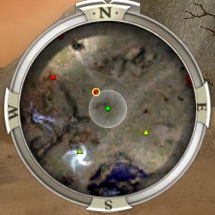Aggro
Aggravate (or Aggro) is the mechanic of whether or not a group of enemies is aware of your presence. When you do not have aggro, enemies will act as if they can't see you. Once you have aggro of a group, they will follow and attack you until either you die, they die, or your entire team breaks aggro.
Understanding how to gain, hold, and break aggro is called aggro control or aggro management. Tanking is a popular form of aggro management which, when done successfully, makes both keeping the party alive and killing foes quicker, easier, and safer than if the whole group held aggro.
Gaining aggro[edit]
The are many ways to gain aggro or take aggro:
- Enter a foe's danger zone AKA aggro bubble.
- Some foes (Siege Wurms, Siege Turtles, Kournan Spotters) have a larger aggro bubble than the one displayed on the compass.
- Very low level foes in starter zones have no aggro bubble at all.
- Enemy corpses also have an aggro bubble; entering it will aggro any living members of that foe's party. This is known as corpse aggro.
- Damaging a foe.
- Pre-casting some skills such as Retribution will not cause aggro when they deal damage.
- Attacking a foe.
- The attack can miss, be blocked, or be dodged, but if it is obstructed, the target will not aggro.
- Damaging a minion or spirit will aggro the foe that controls it.
- Being hit by a foe's attack or taking damage.
- Using a skill with a cast time on a foe.
- Using a skill on an ally that already holds aggro.
- Skills with an instant cast time (e.g. "Make Haste!") will not take aggro.
- If multiple groups of the same monster type are within fairly close range (slightly less than aggro range) of each other, aggroing one group will aggro the others. This is known as chain aggro.
- Enemies Must Die! directly grants aggro to the target.
Breaking aggro[edit]
Breaking aggro or losing aggro means escaping from a group of foes so they break off and return to what they were doing before entering aggro. Known ways of breaking aggro are:
- Moving faster in relation to a foe until the foe breaks off, by increasing the player's run speed or snaring that foe. Ranged foes will continue to attack while the player is in range.
- Leaving the foe's leash range. Most foes will only follow a certain distance from where they took aggro. This distance is longer if the group was patrolling - if they were standing still or balling up, they can only be pulled a short distance; this is known (particular in the DoASC community) as bad aggro.
- Creating a large gap (the required distance depends on the foe) between yourself and the foe. This is usually achieved by shadow stepping.
- Dying.
[edit]
When two or more allies have aggro of a group, the enemies can switch between targeting each ally. This is known as split aggro or shared aggro. The target they choose to focus depends on a number of factors. Whilst these factors are not known, evidence suggests that they include armor rating, current health, movement speed, distance, using skills, whether you are wielding a caster or martial weapon, and how much damage you are dealing.
One ally running away will not be enough for them to lose aggro. Until the entire team breaks aggro, everyone who took aggro will retain it, unless they die.
